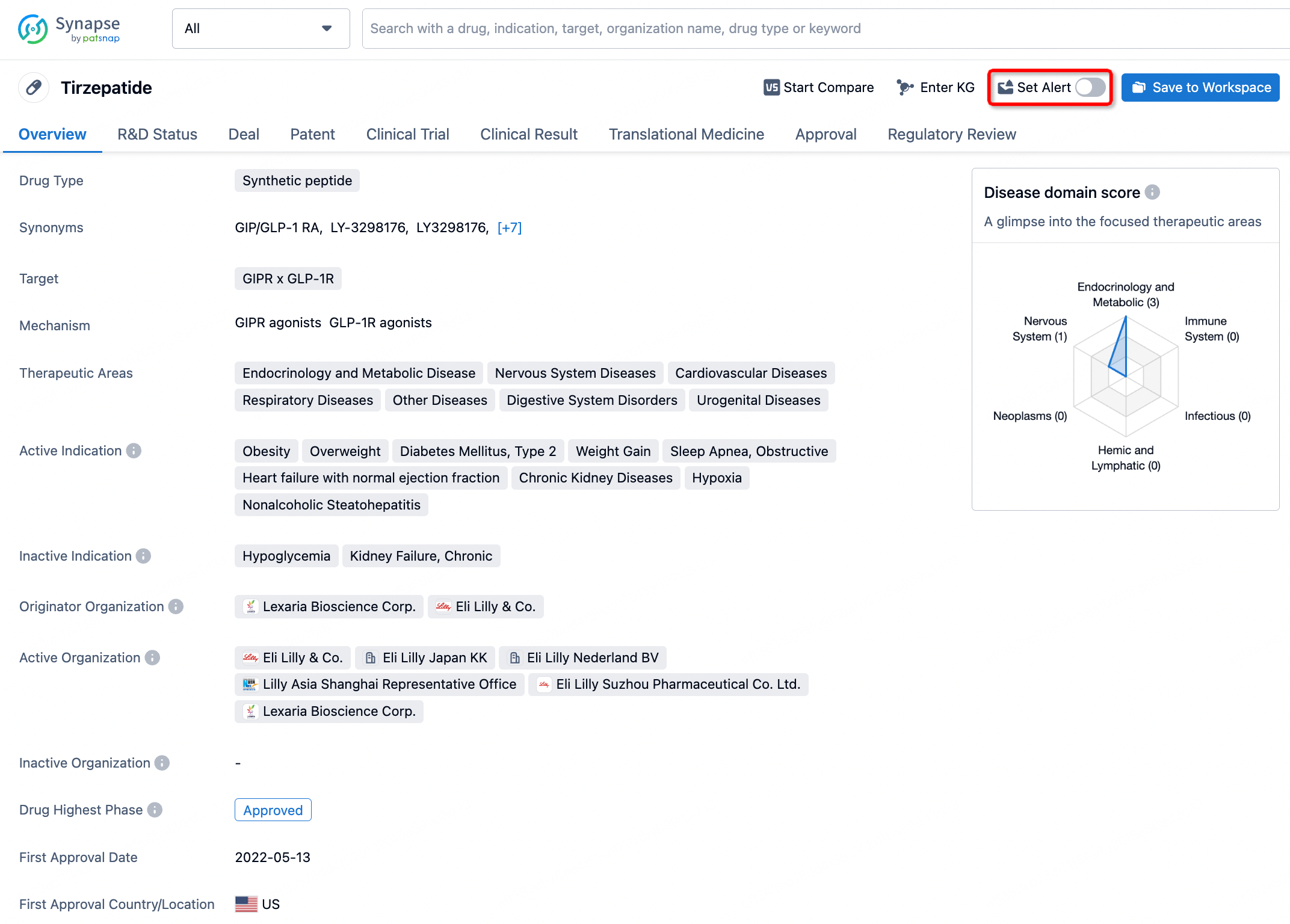Request Demo
What is Etorphine Hydrochloride used for?
15 June 2024
Etorphine Hydrochloride, also known as M99, is a potent opioid analgesic primarily used in veterinary medicine. Trade names for this drug include Immobilon and M99, among others. It is notably one of the most powerful opioids available, with an analgesic potency approximately 1,000-3,000 times that of morphine. This extreme potency makes it highly effective for immobilizing large animals such as elephants and rhinos, a use for which it has no equal in veterinary practice. While etorphine hydrochloride has shown promise in research applications, it is strictly regulated due to its potential for misuse and the significant danger it poses to humans. Research institutions and pharmaceutical companies continue to explore its potential applications, but its use remains limited to controlled veterinary settings.
The primary target of etorphine hydrochloride is the mu-opioid receptor, a class of receptors in the nervous system that mediate the effects of opioids. When etorphine binds to these receptors, it produces profound analgesia and sedation. Because of its potency and the risk of severe adverse effects, its use is confined to specialized settings where the benefits outweigh the risks. The drug is not indicated for human use due to these severe risks, including respiratory depression and death at doses that are therapeutically useful for animals.
The mechanism of action of etorphine hydrochloride revolves around its interaction with opioid receptors in the central nervous system. The drug binds primarily to mu-opioid receptors but also has affinity for delta and kappa receptors. This binding action results in the inhibition of neurotransmitter release, leading to analgesia, sedation, and, at higher doses, immobilization. The drug achieves this by hyperpolarizing nerve cells and thereby preventing the transmission of pain signals. It also depresses the central nervous system, which accounts for its sedative properties.
When administered, etorphine hydrochloride acts quickly, often within minutes, to produce profound sedation and analgesia. Its rapid onset is one of the reasons it is so effective in immobilizing large animals under field conditions. The drug’s duration of action, however, is relatively short, lasting a few hours, which is beneficial for veterinary interventions that require temporary immobilization. The rapid onset and short duration allow for quick medical interventions without prolonged sedation, which can be dangerous for the animal.
Etorphine hydrochloride is typically administered by intramuscular injection using darts or syringes, especially in large, free-ranging animals. The dosage must be carefully calculated based on the animal’s weight and species, as even slight miscalculations can have fatal consequences. The drug’s potency means that only a very small amount is needed to achieve the desired effect, making precision in dosage critical. In a clinical setting, the drug is often administered under the supervision of a veterinarian experienced in its use, and emergency medical equipment, including opioid antagonists like naloxone, must be readily available to counteract any accidental exposure or overdose.
The use of etorphine hydrochloride is not without significant risks. The drug’s side effects can be severe, particularly if administered incorrectly. In animals, side effects may include respiratory depression, bradycardia, hypotension, and excitation upon recovery. These effects necessitate careful monitoring during and after the administration of the drug to ensure the animal’s safety. In humans, accidental exposure to even minute amounts of etorphine hydrochloride can be fatal. Symptoms of exposure include severe respiratory depression, unconsciousness, and potentially death. Because of these risks, anyone handling the drug must use extreme caution and have immediate access to opioid antagonists like naloxone.
There are several contraindications for the use of etorphine hydrochloride. It should not be used in animals that are seriously ill or debilitated, as the drug’s profound effects on the central nervous system and respiratory function can exacerbate existing conditions. Furthermore, the use of etorphine hydrochloride in pregnant animals is generally contraindicated due to the potential for adverse effects on the fetus. The drug should only be used in environments where full resuscitation facilities are available due to the risk of severe adverse reactions.
The interaction of etorphine hydrochloride with other drugs is another critical consideration. The concurrent use of other central nervous system depressants, such as barbiturates, benzodiazepines, or other opioids, can exacerbate the depressant effects of etorphine hydrochloride, leading to increased risk of respiratory depression and death. Therefore, such combinations should be avoided unless absolutely necessary and conducted under strict veterinary supervision. Additionally, drugs that alter the metabolism of opioids, such as certain antibiotics or antifungals, can affect the pharmacokinetics of etorphine hydrochloride, potentially leading to unexpected effects.
In conclusion, etorphine hydrochloride is a highly potent opioid analgesic used primarily in veterinary medicine for the immobilization of large animals. Its mechanism of action involves binding to opioid receptors in the central nervous system, producing profound analgesia and sedation. The drug’s administration requires extreme caution and precision due to its potency and the severity of its side effects, which include respiratory depression and potentially fatal reactions in both animals and humans. Its use is contraindicated in certain conditions and should be managed in environments equipped for emergency interventions. Interactions with other central nervous system depressants or drugs that affect opioid metabolism must be carefully managed to avoid adverse outcomes. Understanding these factors is crucial for the safe and effective use of etorphine hydrochloride in veterinary practice.
The primary target of etorphine hydrochloride is the mu-opioid receptor, a class of receptors in the nervous system that mediate the effects of opioids. When etorphine binds to these receptors, it produces profound analgesia and sedation. Because of its potency and the risk of severe adverse effects, its use is confined to specialized settings where the benefits outweigh the risks. The drug is not indicated for human use due to these severe risks, including respiratory depression and death at doses that are therapeutically useful for animals.
The mechanism of action of etorphine hydrochloride revolves around its interaction with opioid receptors in the central nervous system. The drug binds primarily to mu-opioid receptors but also has affinity for delta and kappa receptors. This binding action results in the inhibition of neurotransmitter release, leading to analgesia, sedation, and, at higher doses, immobilization. The drug achieves this by hyperpolarizing nerve cells and thereby preventing the transmission of pain signals. It also depresses the central nervous system, which accounts for its sedative properties.
When administered, etorphine hydrochloride acts quickly, often within minutes, to produce profound sedation and analgesia. Its rapid onset is one of the reasons it is so effective in immobilizing large animals under field conditions. The drug’s duration of action, however, is relatively short, lasting a few hours, which is beneficial for veterinary interventions that require temporary immobilization. The rapid onset and short duration allow for quick medical interventions without prolonged sedation, which can be dangerous for the animal.
Etorphine hydrochloride is typically administered by intramuscular injection using darts or syringes, especially in large, free-ranging animals. The dosage must be carefully calculated based on the animal’s weight and species, as even slight miscalculations can have fatal consequences. The drug’s potency means that only a very small amount is needed to achieve the desired effect, making precision in dosage critical. In a clinical setting, the drug is often administered under the supervision of a veterinarian experienced in its use, and emergency medical equipment, including opioid antagonists like naloxone, must be readily available to counteract any accidental exposure or overdose.
The use of etorphine hydrochloride is not without significant risks. The drug’s side effects can be severe, particularly if administered incorrectly. In animals, side effects may include respiratory depression, bradycardia, hypotension, and excitation upon recovery. These effects necessitate careful monitoring during and after the administration of the drug to ensure the animal’s safety. In humans, accidental exposure to even minute amounts of etorphine hydrochloride can be fatal. Symptoms of exposure include severe respiratory depression, unconsciousness, and potentially death. Because of these risks, anyone handling the drug must use extreme caution and have immediate access to opioid antagonists like naloxone.
There are several contraindications for the use of etorphine hydrochloride. It should not be used in animals that are seriously ill or debilitated, as the drug’s profound effects on the central nervous system and respiratory function can exacerbate existing conditions. Furthermore, the use of etorphine hydrochloride in pregnant animals is generally contraindicated due to the potential for adverse effects on the fetus. The drug should only be used in environments where full resuscitation facilities are available due to the risk of severe adverse reactions.
The interaction of etorphine hydrochloride with other drugs is another critical consideration. The concurrent use of other central nervous system depressants, such as barbiturates, benzodiazepines, or other opioids, can exacerbate the depressant effects of etorphine hydrochloride, leading to increased risk of respiratory depression and death. Therefore, such combinations should be avoided unless absolutely necessary and conducted under strict veterinary supervision. Additionally, drugs that alter the metabolism of opioids, such as certain antibiotics or antifungals, can affect the pharmacokinetics of etorphine hydrochloride, potentially leading to unexpected effects.
In conclusion, etorphine hydrochloride is a highly potent opioid analgesic used primarily in veterinary medicine for the immobilization of large animals. Its mechanism of action involves binding to opioid receptors in the central nervous system, producing profound analgesia and sedation. The drug’s administration requires extreme caution and precision due to its potency and the severity of its side effects, which include respiratory depression and potentially fatal reactions in both animals and humans. Its use is contraindicated in certain conditions and should be managed in environments equipped for emergency interventions. Interactions with other central nervous system depressants or drugs that affect opioid metabolism must be carefully managed to avoid adverse outcomes. Understanding these factors is crucial for the safe and effective use of etorphine hydrochloride in veterinary practice.
How to obtain the latest development progress of all drugs?
In the Synapse database, you can stay updated on the latest research and development advances of all drugs. This service is accessible anytime and anywhere, with updates available daily or weekly. Use the "Set Alert" function to stay informed. Click on the image below to embark on a brand new journey of drug discovery!
AI Agents Built for Biopharma Breakthroughs
Accelerate discovery. Empower decisions. Transform outcomes.
Get started for free today!
Accelerate Strategic R&D decision making with Synapse, PatSnap’s AI-powered Connected Innovation Intelligence Platform Built for Life Sciences Professionals.
Start your data trial now!
Synapse data is also accessible to external entities via APIs or data packages. Empower better decisions with the latest in pharmaceutical intelligence.


